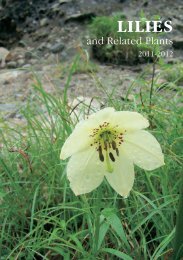LILIES - RHS Lily Group
LILIES - RHS Lily Group
LILIES - RHS Lily Group
You also want an ePaper? Increase the reach of your titles
YUMPU automatically turns print PDFs into web optimized ePapers that Google loves.
Lilium dauricum is mainly a coastal plant on Hokkaido. The bulbs establish<br />
their roots in coastal grassland or on shelves of the steep coastal cliffs. Lilium<br />
dauricum’s communities in coastal grasslands have been reduced by environmental<br />
effects, as their habitat has been altered by the installation of drainage systems for<br />
ranches, and/or by road building. Moreover, some populations are unable to selfpropagate<br />
well from seed, as the young roots of seedlings are prevented from<br />
working their way into the soil by a thick layer of grass thatch. This thatch is now<br />
thicker than in the past, as fewer horses are grazed on coastal grasslands, now<br />
that tractors are used instead. Another possible cause of decline in L. dauricum<br />
is a reduction in the number of its pollinators. It is suggested that the pollinators<br />
of L. dauricum are the largeish butterflies, Aporia crataegi (black-veined white)<br />
and Papilio machaon (swallowtail). Both eat each host plants in their caterpillar<br />
stage. Malus sieboldii (Japanese crabapple) and M. baccata var. mandshurica<br />
(a variety of Siberian crabapple) are the host plants of A. crataega; Glehnia<br />
littoralis (silvertop) is the host plant of P. machaon. In the past, good stands<br />
of these host plants were present near sites of L. dauricum. Now, however,<br />
the host plants have disappeared from some habitats. Malus sieboldii and M.<br />
baccata var. mandshurica have in some places been destroyed by controlled<br />
burning in early spring. The young shoots of G. littoralis were cleanly picked out<br />
as the ingredient of a seasonal salad. G. littoralis lived on the coast of Ishikari<br />
close to my residence, but is now absent around declining communities of the<br />
lily. Although G. littoralis still thrives bravely in the nature refuge ten kilometers<br />
away, pollinators cannot survive outside the refuge.<br />
In nature the range of L. dauricum was limited to coastlines and to some of<br />
the high mountains in Hokkaido. However, in the last 20 years this lily has been<br />
increasingly visible on roadside verges. As its distribution is expanded along<br />
roadsides in the high mountains, there is a fear that this artificial expansion of its<br />
distribution could contaminate relict communities.<br />
Villagers in most L. japonicum regions campaign actively for the protection<br />
of this lily. There are two motivations behind this. Many people are fired by<br />
nostalgia, wanting to recreate the view filled with L. japonicum in full flower,<br />
which villagers used to see as a matter of course every year in the old days. Others<br />
hope to boost their secluded mountain hamlets by attracting a lot of visitors to<br />
see a hillside full of L. japonicum in bloom. Both groups talk about how the lily<br />
has been declining. Conservation activists and the Environment Ministry allege<br />
that the decline is caused by collecting, but my own belief is that it is caused by<br />
lifestyle changes at these mountain village, and by forestry depression.<br />
Ishima, which I visited in 2004, is a small island nine and half a kilometers<br />
around, located east of Sikoku Island. Junior high school students here are<br />
absolutely committed to conserving communities of L. japonicum Ishima form.<br />
11




